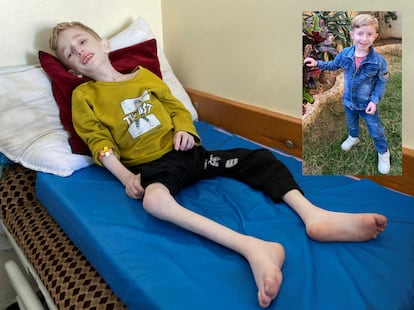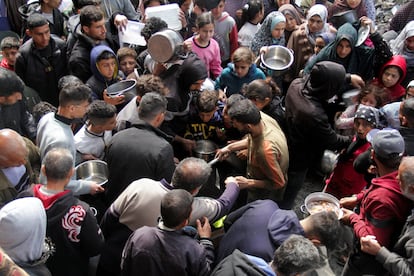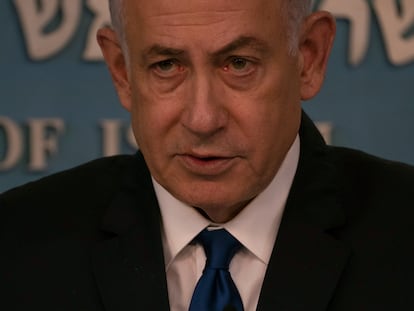Gaza is getting less than half the humanitarian aid it needs to avoid famine
Israel’s obstacles to the delivery of supplies and the way it manages the conflict may involve the use of starvation as a weapon of war, warns the UN

With hunger raging in Gaza after five months of a devastating Israeli military campaign and with catastrophic levels of malnutrition expected to skyrocket in the coming months, Israel’s limitations to the supply of humanitarian aid into the enclave are back in the spotlight. Despite a slight increase in the flow of supplies in recent weeks, Gaza continues to receive less than half the amount of food it needs to meet its minimum needs. “Famine is imminent as 1.1 million people, half of Gaza, experience catastrophic food insecurity,” according to a report published on Monday by the Integrated Food Security Phase Classification, a global initiative made up of United Nations agencies and humanitarian groups.
The entire population in the Gaza Strip (2.23 million) is facing high levels of acute food insecurity, says the report. More than 870,000 people are in an emergency situation and more than 670,000 are in a catastrophic situation, a category into which 1.1 million Gazans, close to half the population, are at risk of falling between now and mid-July, “in the most likely scenario and under the assumption of an escalation of the conflict.”
The crisis is especially severe among children, despite the fact that many adults are reducing their own intake to give them food. There are cases like that of Fadi al Zant, a six-year-old boy who suffers from cystic fibrosis and who, before the war, took medication that his family can no longer find and maintained a balanced diet that is impossible today, Reuters reported. “His condition is getting worse. He is getting weaker. He keeps losing his ability to do things,” said his mother, Shimaa al Zant, in a video obtained by Reuters. The child, with his ribs visible through his skin, sunken eyes and spindly legs, is in a bed at the Kamal Adwan hospital in northern Gaza.
The level of acute malnutrition among the youngest children almost doubled in February from January, and 31% of children under two years of age in the north, and 10% in the southern area of Rafah are already malnourished, according to UNICEF. In recent weeks local health authorities have reported the death of more than 20 children due to malnutrition and dehydration, the vast majority in hospitals in the north, from which images of hungry minors are emerging.
The IPC and UNICEF point out that, in addition to the hostilities, the rapid increase in food insecurity in Gaza is due to extremely limited access to humanitarian aid. These agencies add that famine can only be contained with a ceasefire and the unhindered access to the area of humanitarian agencies. Since the start of the Israeli military offensive last October, essential supplies have arrived in dribs and drabs. The delivery of supplies continues to clash with a restrictive, slow and confusing process imposed by Israel, which includes bureaucratic obstacles, inspections and limits on access points.

“We do not believe there is starvation in Gaza. It’s not that there aren’t difficulties in some areas, but we are doing everything we can to provide large amounts of aid,” said a spokesperson for COGAT, the organization of the Israeli Ministry of Defense in charge of coordinating civil affairs in the occupied Palestinian territories, in statements to The Times of Israel, where he added that the delivery of aid is not being limited.
Israeli government spokesperson Eylon Levy said on Monday on the social platform X that the IPC report’s data is outdated because it did not take into account the most recent humanitarian initiatives. However, the U.N. World Food Programme estimates that at least 300 trucks of food are needed every day to meet the basic needs of the population. During the first half of March, an average of 159 trucks a day have entered Gaza, representing 40% of the minimum amount required, according to U.N. data. Before the Israeli offensive, an average of 500 trucks entered every working day, including fuel trucks.
Humanitarian supplies are brought into the Gaza Strip almost exclusively through two border crossings located in the south, mainly Kerem Shalom and to a lesser extent Rafah. For aid to reach northern Gaza, daily approvals are needed from Israeli authorities, which often mean long waits at a checkpoint in the middle of the enclave, where shipments — which often do not receive the go-ahead — are exposed. to looting. The World Food Programme has only managed to send nine shipments north so far this year.
Getting in is not the only challenge. So is distribution. The COGAT spokesperson, Shimon Freedman, emphasized in statements to this newspaper that the protection of shipments carrying humanitarian aid is the responsibility of the agency that organizes it and that the army cannot guarantee it. The Hamas government police are trying to preserve control over the distribution of aid, which has become a chaotic event in which hungry crowds — or mafias seeking to resell the aid on the black market — raid the trucks. But, in general, Hamas avoids going out into the open to accompany the shipments because this exposes them to bombing by the Israeli army. “The Hamas police are Hamas,” summarizes Freedman. On Tuesday, an Israeli air raid killed Abu al Nur al Bayumi, the police chief of the Nuseirat refugee camp, in central Gaza, along with four other people who were in the same vehicle.
In this scenario, Israel has put agencies in touch with “private contractors” to protect the shipments, explained the COGAT spokesperson. Last week, a Hamas-linked website warned Gazans not to cooperate with Israel in protecting shipments, and Arabic-language media reported that the Islamist militia had killed the leader of a powerful family clan with which it has clashed in the past, the Dogmush. Israel’s plan for the day after the war is to convince family clans in the Gaza Strip to manage the day-to-day. Foreign Minister Israel Katz said this Tuesday in a television interview that the plan will move forward as the invasion progresses. “The more weakened Hamas is, the more alternatives will emerge,” he declared.
Other clans, civil society groups and Palestinian armed factions have begun to provide security for the shipments, according to official Palestinian and Hamas sources cited by the Reuters agency. “Israel’s plan to find some clans to collaborate with its pilot projects of finding an alternative to Hamas didn’t succeed but it also showed that Palestinian resistance factions are the only ones who can run the show, in one way or another,” said an unnamed Palestinian official in statements to Reuters.

U.N. High Commissioner for Human Rights Volker Türk warned on Tuesday that the extent of Israel’s restrictions on the entry of aid into Gaza and the way it is conducting hostilities may amount to the use of starvation as a weapon of war, which is a war crime. International Criminal Court prosecutor Karim Khan had previously warned that preventing aid delivery could amount to a crime and has stressed that Israel must ensure that Gazans receive food, water and medical supplies. Likewise, the U.N. International Court of Justice, which is considering South Africa’s lawsuit against Israel for alleged genocide, urged the country in January to allow an adequate flow of aid.
Given the alarm generated by the incipient famine in Gaza, the United States and the European Union, together with several countries in the region, have in recent weeks promoted alternatives to get aid into the Strip by air and by sea. But these measures have been criticized because they barely make a difference considering the magnitude of the crisis while diverting attention from Israel’s responsibilities. Military planes carrying supplies can carry about 10 times less than a single truck, and the first shipment through the maritime corridor with Cyprus delivered 200 tons of food, equivalent to between 10 and 15 trucks, according to UN estimates. Delivering aid by air and sea also poses significant logistical and distribution challenges, and is much more expensive. At the end of February, the spokesman for the UN Secretary General, Stéphane Dujarric, noted that in Egypt there are 1,000 trucks with 15,000 tons of food that are still awaiting Israeli approval to enter Gaza.
Sign up for our weekly newsletter to get more English-language news coverage from EL PAÍS USA Edition
Tu suscripción se está usando en otro dispositivo
¿Quieres añadir otro usuario a tu suscripción?
Si continúas leyendo en este dispositivo, no se podrá leer en el otro.
FlechaTu suscripción se está usando en otro dispositivo y solo puedes acceder a EL PAÍS desde un dispositivo a la vez.
Si quieres compartir tu cuenta, cambia tu suscripción a la modalidad Premium, así podrás añadir otro usuario. Cada uno accederá con su propia cuenta de email, lo que os permitirá personalizar vuestra experiencia en EL PAÍS.
En el caso de no saber quién está usando tu cuenta, te recomendamos cambiar tu contraseña aquí.
Si decides continuar compartiendo tu cuenta, este mensaje se mostrará en tu dispositivo y en el de la otra persona que está usando tu cuenta de forma indefinida, afectando a tu experiencia de lectura. Puedes consultar aquí los términos y condiciones de la suscripción digital.









































